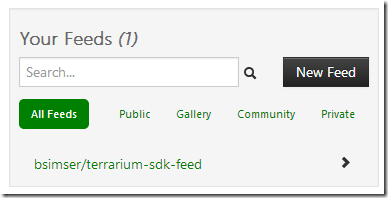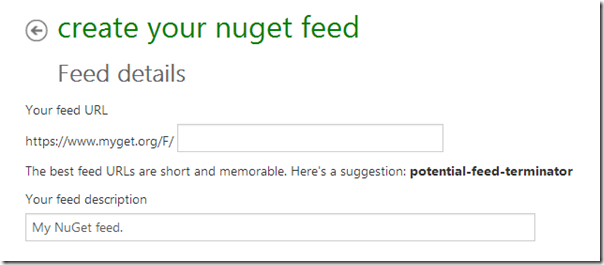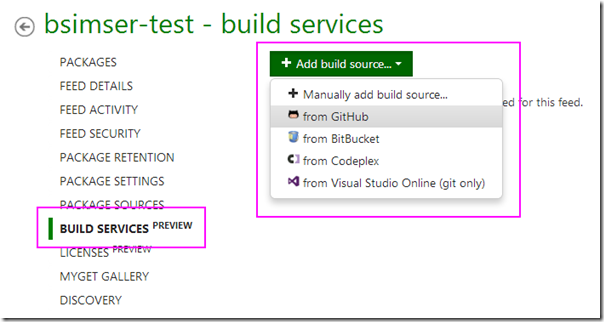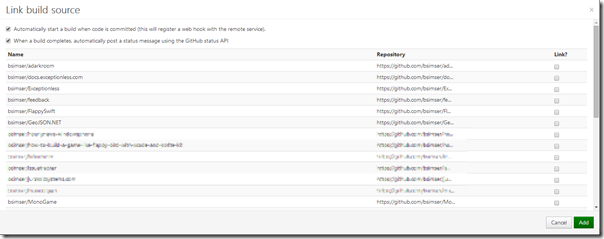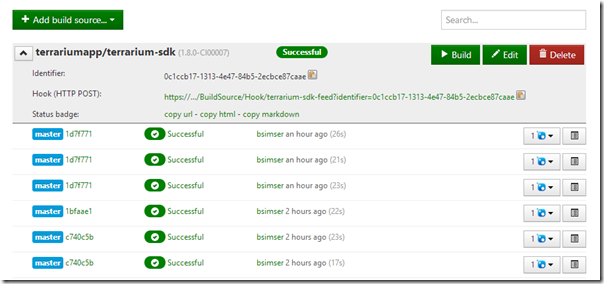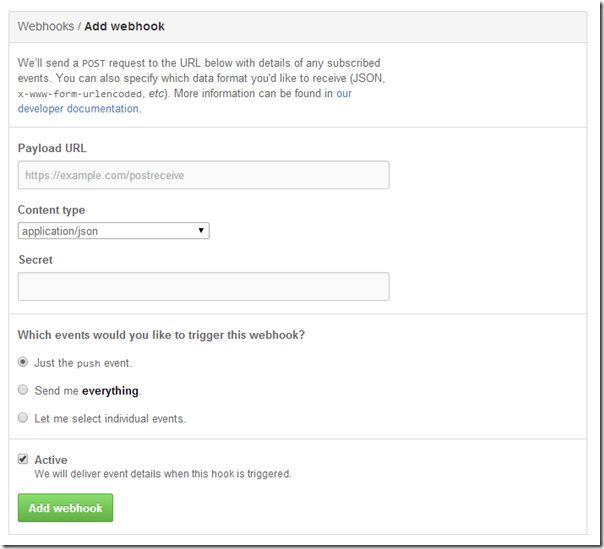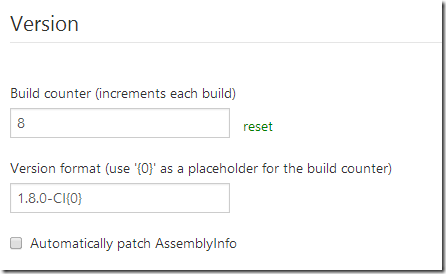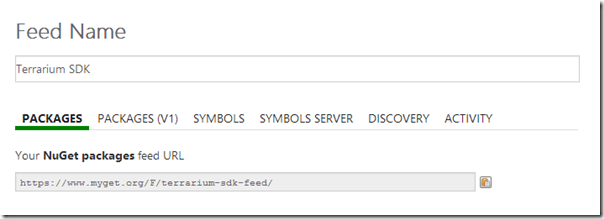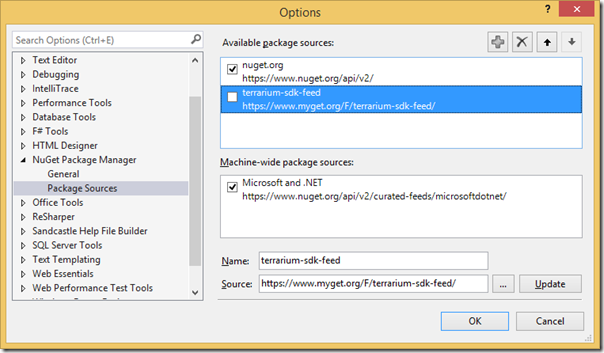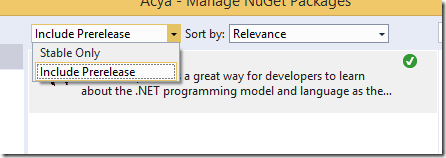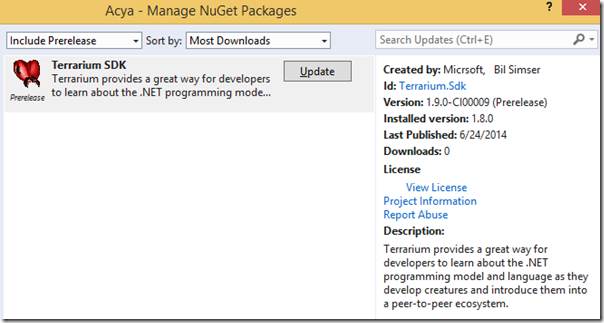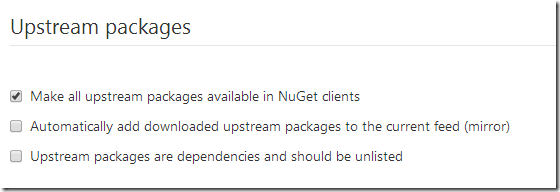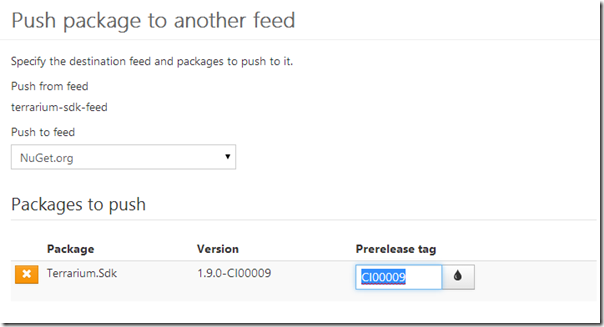Contents tagged with Terrarium
-
Automatically Publishing NuGet packages from GitHub
About an hour ago I didn’t have a MyGet account (although I knew about the service) but did have a repository on GitHub with a package that I was manually updating and pushing to NuGet. Thanks to a recommendation from Phil Haack and an hour of messing around with some files I now have a push to GitHub updating my NuGet package with a click of a button. Dead simple. Read on to get your own setup working.
I’m currently in the midst of a reboot of Terrarium, a .NET learning tool that lets you build creatures that survive in an online ecosystem. More on that later but right now I’ve setup a NuGet package that you add to your own creation to get all the functionality of a creature in Terrarium. The problem was is that I was manually editing a batch file every time I built a new version and pushing that build up to NuGet.
This is 2014. There must be a better way. We have the technology. We have the capability to make this process easy.
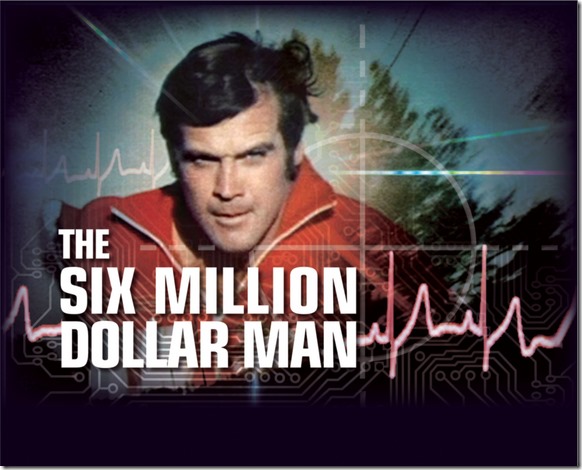
Thanks to a few tweets and one suggestion from Phil Haack I checked out MyGet. At first it didn’t look like what I wanted to do. I didn’t want package hosting, I wanted to build my package from GitHub and publish it to NuGet. After looking at a few pages I realized that MyGet was really a perfect way to setup “test” packages. Packages I could push and push and push and never make public then with the click of a button publish the version from MyGet upstream to NuGet. In addition to a few pages of documentation on MyGet I stumbled over Xavier Decoster’s blog post on how he does it with his ReSharper Razor extension. The post was good and had enough steps to get me going. The MyGet docs are there but the screenshots and some of the steps are a little obscure (and didn’t always match what I was seeing in my browser) so hopefully this post will clear things up and give you a detailed step-by-step on how to do this (with the current version of MyGet, it may change in the future).
What You’ll Need
You’re going to need a few things setup first for this to work:
- A GitHub repository. BitBucket is also supported as well as others but I’ll document GitHub here. Check out the MyGet documentation on what they support.
- A MyGet account. I hadn’t signed up for one until about an hour ago so this is easy (and free!)
- A NuGet account.
- A .nuspec file for your project (we’ll create it in this post)
- A batch file to build your package (again, we’ll create it later)
MyGet Feed
You’re going to need to create a MyGet feed first before anything. So once you have an account you’ll add a feed. There are various places on MyGet to add one (and I think once you verify your account you’re thrown into the screen to create one). In the top login bar next to your name you’ll see a file icon that says “New Feed”
There’s also a “New Feed” button in the Your Feeds box on your activity stream page.
Once you click it you’ll be taken to a page where you enter the details of your new feed.
Enter a name for the feed. The first part of the URL is already filled in for you but you specify whatever you want. This will be your URL that you’ll enter into the Package Manager to consume your feed. You can also enter a description here.
Next you get to determine how your feed is to be used. By default it’s public but you can also create a community feed (where anyone can push and manage their own packages on the feed).
With a paid account you can also have a private feed where you invite users to access it.
Click on the Create feed button to finish the setup. Once you create the feed you’ll be dumped to the main page of the package where you can select various settings to configure your package feed. By default there’s nothing there so we’ll build up our package.
Getting Your Code
First thing you want to do is add a Build Service. A build service is a mechanism to tell MyGet how to build your project. This will clone your GitHub repository on MyGet and build your package. Detailed information about the Build Services can be found here.
Click on Build Services then click on the Add build source button. This will allow you to select a build source where you’ll pull your code from.
Here you can see you can add a GitHub repository, BitBucket, CodePlex, or Visual Studio Online service (or you can add one manually).
Choose GitHub and you’ll be asked to authorize MyGet to interact with GitHub (along with maybe signing into GitHub). Once you authorize it you’ll be shown a list of repositories on GitHub you can select from. Choose the one you’re going to build the package from by clicking on the Link? checkbox and click Add (some repositories below are obscured but yours won’t be).
Once you add the build source you now have the information to setup GitHub for the webhook. Expand the build source to show the information MyGet created for it and you’ll see something like this:
Initially you won’t have any builds but this is where you’ll see those builds and their status. What’s important here is the Hook url. This is the value we’re going to use on GitHub to trigger MyGet to fetch the source when a push occurs (and build the package).
Copy the Hook url (there’s a small icon you can click on to copy it to your clipboard, typing is for weenies) and head over to your GitHub project you selected for the build source.
Webhooks
On GitHub in your repository go to Settings then click on Webhooks and Services. Click on Add webhook to show this dialog:
In the Payload URL paste the Hook URL that you got from MyGet. Leave the Content type as application/json and the radio button trigger to just work off the push event then click Add webhook.
This will add the webhook to your GitHub repository which, on a push to the repo, will trigger MyGet to do it’s stuff.
Building
Now its time to setup your package creation in GitHub and create a package. Remember, MyGet is going to be doing the fetching of the source code from GitHub and compiling and packaging. The trigger will be when you push a change to GitHub (you can also trigger the build manually from MyGet if you need to).
By default MyGet will search for a variety of things to try to figure out what to do with your codebase once it gets it. While it does look for .sln files and .csproj files (and even .nuspec files) I prefer to be specific and tell it what to do. The build service will initially look for a build.bat (or build.cmd or build.ps1) file and run it so let’s give it one to follow.
Xavier provides one in his RazorExtensions repository so I (mostly) copied that but he’s doing a few things to support his plugin. Here’s a more generic build.bat you can create that should be fine for your project:
Loading gist https://gist.github.com/8c5d08f0f5fc0b7626d0.json...- Line 2-5: These lines setup the configuration we’re going to use. This would be “Release” or “Debug” or whatever you have defined in your solution. If it’s blank it will use “Release”.
- Line 7-10: This sets up the PackageVersion value that will be passed onto NuGet when creating the package. Again, if it’s blank it will use 1.0.0 as the default.
- Line 12-15: Here we’re setting the nuget executable. If you have a specific one in your solution you can use it, otherwise it’ll just use the one available on MyGet (which is always the latest version)
- Line 17: This is the msbuild command to run your solution file. My solution file is in a subfolder called “src” so I specify that way, yours might be at the root so adjust accordingly. The %config% parameter is used here to select the build configuration from the solution file. The other values are for diagnostic purposes to provide information to MyGet (and you) in case the build fails.
- Line 19-21: Here I’m just setting up the output directories for NuGet. All packages will get put into a folder called “Build” and follows the standard naming for NuGet packages. Right now I just have a .NET 4.0 library but other files may come later. Build up your package folder structure accordingly (the docs on NuGet describe it here).
- Line 23: Finally we build the NuGet package specifying our .nuspec file (again mine is in a subfolder called “src”) and the version number. The “-o Build” option is use the Build directory to output the package.
Okay now we have a build.bat file that MyGet will run once it grabs the latest code from GitHub. Commit that (but don’t push yet, we’re not ready). Next up is to build the .nuspec file that will tell NuGet what’s in our package. You can create the .nuspec file manually or using NuGet to scaffold it for you (docs here). There are also some GUI tools and whatnot to build it so choose your weapon.
Here’s my .nuspec for the Terrarium SDK:
Loading gist https://gist.github.com/37115a0d4d3558d41b7b.json...Pretty typical for a .nuspec file and pretty simple. It contains a single file, the .dll, that’s in the “lib/net40” folder. A few things to note:
- My assembly is in the project directory but the .nuspec file is in the “src” folder so the package contents are relative to where the .nuspec file is, not where the system is running it from (which is always the root with MyGet)
- We use the $version$ and $configuration$ token to replace paths and names here. These are set in the batch file prior to invoking NuGet.
Okay now we’ve got the .nuspec to define our pacakge, the source code wired up to notify MyGet, MyGet to get it on a push, and a batch file to create our package.
Push the code changes into GitHub and sit back. You can go to your Build Services page on MyGet for your feed, expand the chevron next to your feed name, and watch an automatically updated display pull your code down and create your package.
If things go wrong feel free to ping me and I can try to help, but realize that everyone’s setup is different. Check the build log for immediate errors. When MyGet fetches your repository it’ll clone it into a temporary directory and then start looking for build.bat and other files to invoke. That’s why we want to put our build.bat file in our root (mine isn’t but I’ll probably change that at some point) so we can get his party started.
A Package Is Born
Once you have a successful build you’ll see your new package under the Packages section.
Cool. You can click on the Package Id to see more detailed information about the package and also manage old releases. Unlike NuGet, MyGet let’s you delete packages rather than just unlist them.
One thing to note here is the version number. Where did that come from? In the screenshot above my version number is 1.8.0-CI0007.
MyGet follows Semantic Versioning (which is a good thing). I do recommend you give it a quick read and consider adopting it. It’s easy and lets people know when things are potentially going to break (if you follow the 3 simple rules about major, minor, and patch version). Semantic Versioning regards anything after the patch number to be whatever your want (pre-release, beta, etc.)
So about that build version. Go back to Build Services in MyGet and for your GitHub source you’ll see a button next to Build called Edit. Click it and it’ll bring up the details about the source that lets you configure how the code is fetched from GitHub.
So down a bit you’ll see a section called Version. Here you can set (or reset) a build counter. Each build on MyGet increments the counter so you know how many times the system was built (you can also use this to track what version is available or how far it’s drifted from source control or different builds in different environments, etc.). The version format field lets you enter your Semantic Versioning formatted value and use {0} as a placeholder for the counter. By default it's set to 1.0.0-CI{0} meaning that your first build is going to be labeled 1.0.0-CI000001 (the build number is prefixed with zeros).
That’s where it came from so anytime you need to bump up the major, minor, or patch version just go here to change it. As for the extra bit we’ll get to it shortly but the default version works and won’t make it’s way into our “production” versions of our package.
Consuming the Package
Now that we have a package we can add it to our package sources in Visual Studio and install it. Again this post is written from the perspective of using MyGet as your own personal repository where you can test out packages before releasing them to the public. While public packages are the default (and free) version on MyGet, you can keep pushing pre-release versions up to MyGet until you’re happy with it then “promote” it to NuGet.
In MyGet click on your package and select Feed Details from the menu. You’ll see something like this:
This is your NuGet feed from MyGet for this package. Copy it (again with the handy icon) and head into Visual Studio.
In the package manager settings add this as a package source. I just add it while I’m developing and testing the package and then disable it (so it doesn’t get confused with the “official” NuGet server). You can easily flip back and forth between packages this way.
I just name the MyGet feed after the package because it’s for testing. Activate the MyGet feed (and to avoid confusion disable the NuGet one) and then return to the managing pacakges for your solution. Select your MyGet feed from the Online choices in NuGet to see your package.
Remember that MyGet is (by default) building a pre-release version (as indicated by the –CI{0} in your version number). This means you need to select the “Include Prerelease” dropdown in the Package Manager:
You should see your package with the same version as MyGet is showing.
At this point you can install your package into a test or client app or wherever you’re using the package. Make changes to it, push the changes to GitHub and magically MyGet will fetch the changes and republish the package for you. Just go into the Updates section in NuGet to see them. Here’s a new package that was created after pushing a change up to GitHub as it appears in the Package Manager GUI in Visual Studio:
Here you can see we have 1.8.0 installed (from NuGet.org). I changed my package source to MyGet feed and there’s a new version available. It’s labeled as 1.9.0-CI00009 (Prerelease).
Like I said, you can keep pushing more versions up to GitHub and go nuts until you’re happy with the package and are ready to release.
Upstream to NuGet
The last piece in our puzzle is having MyGet push a package up to NuGet. This is a single click operation and while it can be automatic (for example pushing everything from MyGet to NuGet) you might not want that. Users would get the pitchforks out and start camping on your doorstep if you pushed out a new version of your package 10 times in a day.
Package Sources are the way to get your feed out. By default one for NuGet.org is even created for you, but it’s not configured or enabled. Click on the Package Sources and you’ll see the NuGet.org one. Click on edit (assuming you have a NuGet.org account and API key).
Enter your information to allow MyGet to talk to NuGet and in the upstream section you’ll see this:
Check the first option. This allows you to push a package from MyGet to NuGet.
Finally we’re ready to go but we don’t want version 1.9.0-CI00108 to be going public. So here’s where Semantic Versioning comes into play. Back in MyGet click on Packages on your package and then click the Push Latest button.
Here’s where the magic happen. MyGet recognizes the “–CI00009” is the prerelease tag in our version. If we leave this in, it’ll push the prerelease up to NuGet. Maybe this is okay but for my use I want to only push up tested packages when I’m ready to release them.
Clear the Prerelease tag field out. This means that will ignore that tag that’s in your version number and only push the version up using the major.minor.patch (in this case 1.9.0 will be pushed up to NuGet.org).
Click Push and in a few minutes it’ll be on NuGet with the newest version.
That’s about it. I know this was long but it was step-by-step and hopefully it should clear up some fuzziness with the process of automatically publishing your GitHub repositories as NuGet packages. As typical it actually took me longer to write this up then to actually do it.
I encourage you to check out more documentation on MyGet as this just scratches the surface as to what it can do and even in this project there are additional options you can leverage like automatically patching AssemblyInfo.cs in your build, labeling the source when you push from MyGet to NuGet, etc.
Feel free to leave your comments or questions below and enjoy!
-
Terrarium, Terrarium, Terrarium
I'm presenting a talk around Terrarium development at the Edmonton .NET User Group on September 25th. The talk is focused on upgrading a legacy app (1.1) to 2.0 (and beyond to 3.5 eventually), building and running your own Terrarium (complete with man-eating critters), and the future roadmap.

Here's the session abstract:
Terrarium was created by members of the .NET Framework team in the .NET Framework 1.0 timeframe and was used initially as an internal test application. In Terrarium, you can create herbivores, carnivores, or plants and then introduce them into a peer-to-peer, networked ecosystem where they complete for survival. Terrarium demonstrates some of the features of the .NET Framework, including Windows Forms integration with DirectX; XML Web services; support for peer-to-peer networking; support for multiple programming languages; the capability to update smart client, or Windows-based, applications via a remote Web server; and the evidence-based and code access security infrastructure. This session is to explore the newly open sourced tool and talk about aspects and challenges around porting the 1.1 code to 2.0, introducing new framework features, updating the architecture. As well, we’ll look at building new creatures to introduce to your terrarium; how the entire eco-system works from a developers perspective, and the future roadmap where the Terrarium community is going.
I'll also be presenting the same session to the Calgary .NET User Group, we're just finalizing a date. See you there!
Update: The Calgary .NET User Group presentation is confirmed for October 1st. Details can be found here on their site. The talk will be titled "The interaction of feeding and mating in the software development control of a Terrarium".
-
Public Terrarium Server Available
I’ve put my own server up and running for you to connect to with the new Terrarium Client and upload your critters to. It’s available at http://www.terrariumserver.com (and will be the default new server in the next build).
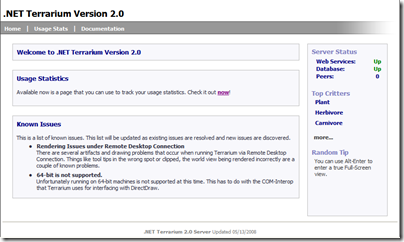
To configure your Terrarium Client to talk to the new server, on the main screen find the icon (2nd one in) that will take you to the settings screen:
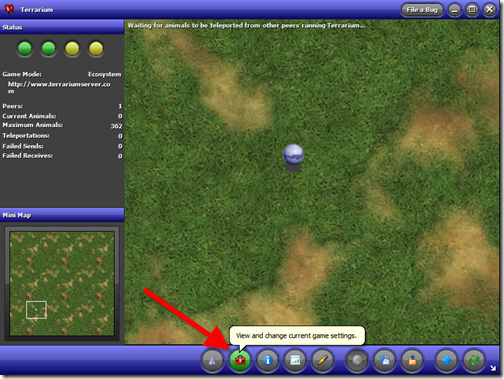
Click on this and you’ll see this dialog:
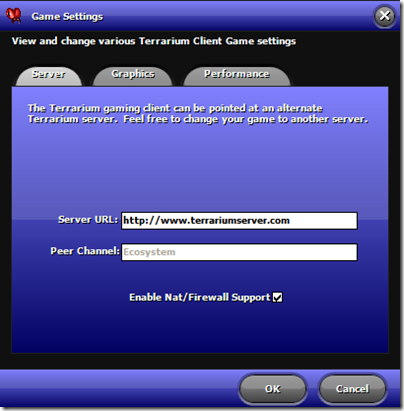
Enter in the values you see above (http://www.terrariumserver.com) and you’ll be good to go. The server is running right now and waiting for creatures to be uploaded so good luck and please use it. Please don’t be abusive as this is a free service and I don’t want to have to spend a lot of time maintaining this guy.
I’m working on two additional sites. http://wiki.terrariumserver.com will host a public wiki that you can exchange design tips, ideas, and strategies with each other. http://creations.terrariumserver.com will become a Digg like community for creatures where you can showcase your work and vote on other peoples animals.
Watch for the new sites to come online in the next week or two (just trying to get the wiki setup before I leave for vaction but having site creation problems).
Enjoy!
-
Terrarium for Vista, whoops…
My bad. I don’t run Vista. Really. I don’t like it, it’s glacially slow, and doesn’t give me anything as a developer (except more flashy looking Explorer screens and maybe a Start menu I can search). So I’m an XP boy, however that was a bad mistake on my part with the release of Terrarium.
Vista users were getting an exception message and it was pretty quick to see that it was a DirectX problem. The problem was a) Vista doesn’t support DirectX 7 which Terrarium requires and b) Bil is an idiot for not thinking about this. Again, my bad and I apologize.
So first off there’s a quick fix (which I can’t test myself, but according to comments on Scott’s blog it works).
- Find an XP machine and grab the following older DirectX DLLs:
- Run regsvr32.exe against the dx7vb.dll and dx8vb.dll
- Drop everything in the %SYSDIR%\system32 folder
d3drm.dll
dx7vb.dll
dx8vb.dllThat should fix you up in the interim. Unfortunately I cannot redistribute the files to you as they’re MS property and all that jazz.
For longer term, I’m ripping out the DirectX COM calls (which are actually wrappers to wrappers) that are in the current codebase and calling the DirectX managed ones provided in DirectX 9. This will probably result in not only a more readable codebase (and one that works on Vista) but it might even gain a little performance along the way.
The managed DirectX classes Microsoft provides in DirectX 9 are pretty nice and rather than a bevy of cryptic constants, enums and ref objects everywhere they’re all wrapped up in a nice OO-like package for you.
For example here’s the old DX7 code (ugly COM and DirectX goo):
1: /// <summary>
2: /// Determines if the surface is in video memory
3: /// or system memory.
4: /// </summary>
5: public bool InVideo
6: {7: get8: {9: if (surface != null)
10: {11: DDSCAPS2 ddsc = new DDSCAPS2();
12: surface.GetCaps(ref ddsc);
13: if ((ddsc.lCaps & CONST_DDSURFACECAPSFLAGS.DDSCAPS_VIDEOMEMORY) > 0)
14: {15: return true;
16: }17: }18: return false;
19: }20: }As with most DirectX code you come across, it’s rather cryptic and ugly. Here’s what this method will look like after the conversion to use the DirectX managed classes:
1: public bool InVideo
2: {3: get4: {5: if (surface != null)
6: {7: SurfaceCaps ddsc = surface.SurfaceDescription.SurfaceCaps;8: return ddsc.VideoMemory;
9: }10: return false;
11: }12: }Much nicer and more readable (well, as readable as DirectX code can ever be).
In any case, this is a better place to be but it’ll be awhile before I can commit all this work (and I’m flying without unit tests which is killing me here). I’m now re-living my past life when I knew what DDSCAPS_VIDEOMEMORY was (and regretting it as it all comes flashing back to me now). This probably won’t get us much closer to an XNA implementation of Terrarium but it’ll cause me to pull out less of my hair when we do (I think).
This fix will be in a 2.1 release that I’ll pump out when I get back from vanishing into the backwoods of British Columbia next week (sorry, but we geeks do need our downtime once in awhile).
I really need to sit down with Kyle Baley and Donald Belcham at ALT.NET Canada and have a few beers over this Brownfield effort for sure.
-
Reintroducing Terrarium, now with 2.0 goodness!
 To skip to the chase… http://www.codeplex.com/terrarium2
To skip to the chase… http://www.codeplex.com/terrarium2Origins
A long time ago, on a development team far, far, away, some bright dude (or dudette) came up with the idea of Terrarium.
Terrarium was a .NET 1.x game/learning tool that was aimed at getting people interested in .NET and building cool stuff. In Terrarium, you can create herbivores, carnivores, or plants and then introduce them into a peer-to-peer, networked ecosystem where they complete for survival. Terrarium demonstrates some of the features of the .NET Framework, including Windows Forms integration with DirectX®; XML Web services; support for peer-to-peer networking; support for multiple programming languages; the capability to update smart client, or Windows-based, applications via a remote Web server; and the evidence-based and code access security infrastructure.
Terrarium was created by members of the .NET Framework team in the .NET Framework 1.0 timeframe and was used initially as an internal test application. At conferences and via online chats, Terrarium provided a great way for developers to learn about the new .NET programming model and languages as they developed creatures and introduced them into a peer-to-peer ecosystem.
The Windows SDK team evolved the game in the .NET Framework 2.0 timeframe, but it wasn’t worked on for over two years. As a result, the source code for Terrarium 2.0 doesn’t use the very latest .NET technologies.
Now here we are and it’s 2008, long past that 1.x product. A few months ago I got the bright idea to resurrect the project. After all, 1.x was long gone from the developers toolkit but the premise of building battle bugs and having them duke it out in a virtual eco-system was still just too plain cool to pass up. I thought it would make for an interesting project and get some renewed interest in .NET, and more specifically upgrade it to the latest framework and goodies out there. Hey, XNA is here and writing DirectX goo is a thing of the past.
The Long And Winding Road
So with my ambition and fearlessness of the Microsoft release monster, I trudged into the mouth of the beast. I hit up as many people I could find that were still around and pinged them about Terrarium.
Terrari-who?
That’s the general response I got for the most part. It’s been 6+ years and most of the original team has moved on. The challenge was to get anyone in Microsoft to find the unreleased source to this project, let alone even remember it.

I pictured a giant warehouse much like the last scene in Raiders of the Lost Ark. Boxes and boxes with cryptic product codes and license keys on them, all packaged up for someone to unearth someday. That someone was going to be me. Terrarium is my Lost Ark. So I persevered and continued to bug everyone I knew, finally ending up at Scott Guthrie who finally put me in touch with Lisa Supinski, Group Manager with the current Windows SDK team.
Lisa was instrumental at getting everything going and handling all the details of making this a reality. Without her, it wouldn’t have come to this point. From there the journey was fraught with danger, snakes, legal papers to read, source code to fix, and agreements to sign (did I mention the snakes?) and lots of emails, phone calls, and secret handshakes.
The fruit of our labour is upon us so now I proudly present…
Terrarium 2, Electric Boogaloo!
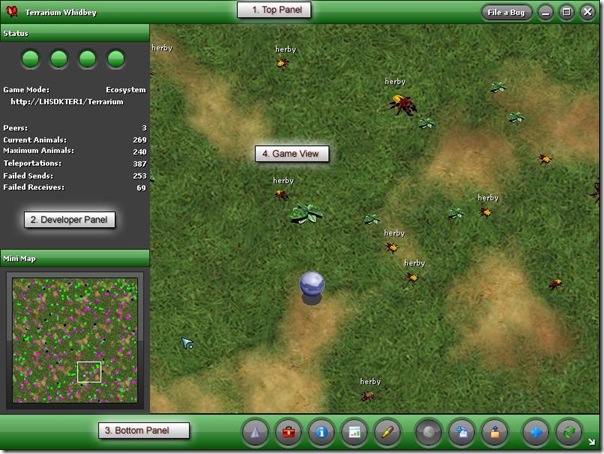
(okay, we’ll drop the Electric Boogaloo part)
Here We Go
The new Terrarium comes in two forms, the client and the server. The client consists of a few parts including a local Terrarium client executable (which also doubles as a screensaver), and SDK documentation and samples for building your own creations. The local Terrarium client and run your own critters but you’ll need a server to connect to if you want it to interact with other creations.
The client can run in two modes:
- Terrarium Mode – 1) The user may run alone, without peers. In this case, the ecosystem presented on the screen represents the whole of the ecosystem. This is good for creature testing purposes. 2) The user may also elect to join with a select group of peers, expanding the ecosystem across all of the participating peer computers. This is simple to do. Each participating user opts into a special, private network by entering an agreed upon character string in the “channel” textbox on the Terrarium console. Upon entering that string, the user’s computer is matched with only those computers which also entered that same string.
- Ecosystem Mode – This is the standard mode, in which the user’s computer runs just a small slice of an ecosystem which spans all of the participating peer computers, worldwide.
In both modes, you can develop your own creatures or you can watch as other developers’ creatures battle it out for survival by running Terrarium as a standalone application or as a screensaver.
The server is two parts. First there’s the web server part which consists of a single web server that provides a user interface for monitoring a Terrarium server (and all the critters uploaded to it) and there are web services that are consumed by the client (for uploading creatures, getting stats, interacting with peers, etc.). The server also includes some SQL scripts and installation instructions for setting up the database. Any flavour of SQL Server will work (2000, 2005, Express). 2008 is untested but should work fine. The scripts are pretty simple (the tables are pretty basic) and there are some stored procedures which could be ported to work with other servers (MySQL, Firebird, etc.) but that’s an exercise I’ll leave to the reader.
Custom Creatures
When creating a creature, you have control over everything from genetic traits (eyesight, speed, defensive power, attacking power, etc.) to behaviour (the algorithms for locating prey, moving, attacking, etc.) to reproduction (how often a creature will give birth and what “genetic information,” if any, will be passed on to its offspring). Upon completing the development process, the code is compiled into an assembly (dynamically linked library, or DLL) that can be loaded into the local ecosystem slice, viewable through the Terrarium console. When a creature is initially introduced in Ecosystem Mode, ten instances of it are scattered throughout the local ecosystem. No more instances of that creature may be introduced by that user or any other on the network until the creature has died off completely. By contrast, if running in Terrarium Mode, an infinite number of instances of a given creature may be entered into the environment.
Once the creature is loaded into Terrarium, it acts on the instructions supplied by its code. Each creature is granted between 2 and 5 milliseconds (depending on the speed of the machine) to act before it is destroyed. This prevents any one creature from hogging the processor and halting the game.
Within each peer in the network, a blue “teleporter” ball rolls randomly about. If the user is running with active peers logged in (either in Ecosystem Mode or using a private channel in Terrarium Mode), whenever this blue ball rolls over a creature, that creature is transported to a randomly selected peer machine.
In the SDK zip file there’s a help file and several samples to get you up and running instantly with a local Terrarium. Feel free to modify these or use them as a starter for your own new creations. Code samples are in both VB.NET and C#.
The Road Ahead

Putting Terrarium on CodePlex was intentional as it’s meant to be a collaborative piece. Getting the system out there is three fold and having it on CodePlex supports this:
- Get the code out there for all to see and dissect
- Get people setting up Terrarium servers and creating bugs (virtual ones for the game, not defects)
- Extending the game as a learning tool and introducing new features to breathe new life into this puppy
Like I said, the current build is for 2.0. I didn’t want to delay the release while I upgraded it to 3.5 since I wasn’t going to be adding any value (yet) to the codebase and there might be some challenges with 3.5 and the DirectX code (I haven’t tried an upgrade yet, so it could “just work”). The other challenge is driven by you, being the fact that not everyone is building in Visual Studio 2008 and targeting the 3.5 framework. So I didn’t want to exclude a large number of developers by forcing them to 3.5. I think time will tell (via the CodePlex forums and feedback on this project) when the right time to move to 3.5 will be (and how, for example will we maintain a 2.0 and 3.5 codebase?). I don’t have all the answers but I’m here to listen and juggle the kittens for everyone.
What’s planned? Here’s my product backlog that will probably make it’s way onto the Issues page on the CodePlex project. These are just seeds for ideas, I’m sure you guys can come up with better ones.
- 3.5 framework/Visual Studio 2008 upgrade (possibly split off and have dual solutions/project files?)
- Leverage 2.0 language features. Much of the code was 1.1 so generics and other goodness wasn’t there. The current codebase is compiled and built on Visual Studio 2005/2.0 Framework but not really making use of the features (yet). For example, all WinForms are 1.1 style (i.e. no partial classes). Same with the 3.5 upgrade where more cool stuff could be done all over the codebase.
- Extend the current system by adding new features. Not sure off the top of my head what those features would be but there’s plenty of room for improvement.
- Bug hunt. I don’t have a list from Microsoft of bugs that were there but no software is perfect. I’m sure things will crop up. We’ll log them in the Issue tracker, you guys should vote on them, and we’ll fix them up as they’re prioritized by popularity.
- ClickOnce install of the Terrarium Client from a Terrarium Server. This would be a nice-to-have since ClickOnce is a breeze to keep clients updated. However it would require some reshuffling of the current client as it requires additional files and ClickOnce has limitations on what it can put on a users machine.
- VSI project template add-ons so people can create new creatures in Visual Studio quickly and easily (this would be a value-added mod and pretty simple to do).
- XNA upgrade/port. This is pretty major as DirectX isn’t really all that abstracted away in the current system but the hope would be to bring Terrarium to the Xbox 360 (complete with networking support). This is probably a 4.0 release that could be a year or so away (but would kick the llamas’ butt)
- Documentation isn’t awesome yet. The SDK help file has been updated and is current (built with the latest release of Sandcastle) but some of the documentation files are a little out of date.
- The server project website is a bit of a mess (read:disaster). It was built in the 1.1 days and never updated. It contains a mixture of code behind files, raw class files, and aspx pages with embedded code. In short, it needs to be rewritten. The web services are okay, although with moving to 3.5 we should probably look at using WCF instead.
Jumping into the project is not for the casual developer. As this codebase came from Microsoft there are some guidelines and constraints we’re going to follow. The first being team members. Please understand this is neither the Blue Monster talking or me being an uber-control freak, it’s just how it is. So if you’re interested in joining the team and contributing there are a few things that have to happen:
- First off, you’ll need to submit a patch to me as a sample of what you’re planning to do or an example of how you’re looking to extend things. This would be something meaningful, but doesn’t have to be an epic contribution (like porting DirectX to XNA). The patch itself won’t go in by me, it’s your golden ticket into the world of the Terrarium team. You will have to modify the codebase with the changes once you gain access (below). I know, it’s rather convoluted and you can beat me up next time you catch me on the street. I don’t make up the rules, I just make sure everyone in the sandbox is playing by them.
- Second, you’ll need to be committed to development. The “submit a patch and run” technique won’t cut it here so we’re looking for some kind of commitment to the project. There’s a signup process involved (requiring you to digitally sign a Microsoft agreement, don’t worry it’s quick, painless, and pretty cool technology to boot) so becoming a team member is a bit more involved than your average open source project.
Like I said, it’s a little more tasking than a typical CodePlex project and there are constraints we can talk about via email or whatever if you’re really interested in enhancing or extending Terrarium and becoming a member of the team.
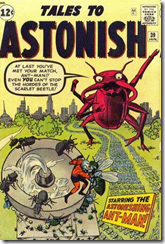
You can grab the various packages now from the release page on CodePlex here. There are packages in various formats:
- Client – This is the client installer. You can run a local terrarium for testing creations and connecting to remote servers.
- Server – This is the server installer and consists of a webserver along with some SQL server files (and instructions for installation). This allows you to setup a server for other people to upload their beasties to.
- SDK – This contains the documentation for building new animals along with some samples (in both VB and C#). You’ll need the client installed first in order to use this package.
- Source – This is the source code package for the entire system. Unzip this and load it up to do customizations. See the notes above for contributing back to the project.
Just a couple of final notes.
Client/Server versions are very sensitive. This is due to security and not allowing clients to “take over” the server or upload malicious code. So if you’ve decided to create your own fork of the code or are running a “custom” server, be aware that only clients that are keyed to your server (based on version) will work. Other clients may have issues connecting or interacting with your server.
The server setup is not fully automated (and probably could be via a MSBuild script or PowerShell script) so there’s some manual intervention needed. The website installs via an installer but you’ll need to create a database and run the scripts provided then do some manual editing of the web.config file to connect to the db. This is all documented in the server package. If you do spin a server up let us know (via the CodePlex project). Maybe we’ll have a dedicated wiki page with active servers people can connect to or something.
I’m also thinking of setting up a new domain and website for a creature exchange program. Upload your creatures, put them to battle, and show them off. Sort of a Digg for Terrarium. Let me know if you have ideas on this or want to help out (I always have 10x more ideas than I have time for). In any case, they’ll be more blog posts to come on building critters and the fine art of Terrarium A.I. (the “A” is for Artificial and the “I” is for intelligence. Wait, what’s the “A” for again?).
I do have a Terrarium 2.0 server up and running at http://terrariumserver.com that you can use for testing (which may or not be fully operational when you read this due to power outages in Vancouver). It’s a playground but can be used for checking out your battle bugs before you unleash them on other unsuspecting victims. This server will always be running the latest version of the server and have the most current (working) features available.
This is a “1.0” type release since it’s the first release of the source code. A few things (as you’ve read) have been done along the way and it’s by no means perfect or complete. It’s just the first step of the journey.
Differences from the Previous Version
For those that remember (or even still have copies of the old version of the program) I wanted to point out a few differences that you (or may not) notice in comparison.
- Several custom executable are missing from the 2.0 release, namely the custom skin tool and some other utilities. We’re working on finding these and/or rebuilding them.
- The custom charting component was removed from the server website and is not available. The project is trying to stay true to an out-of-the-box experience so the decision was not to clutter up the core project with 3rd party utilities and libraries. This functionality may return in some form, once there’s a way to do it with the core .NET framework
- Documentation you find may refer to items or concepts that are non-existent in the 2.0 version (this is mainly prevalent in the Client UI as that has changed quite a bit). The documentation is an on-going effort and will evolve over time.
- Some “features” in the Client are not working or wired up. For example the “Report a bug” button does nothing. They’ll be various bits and pieces that are like this which, again, will come with time.
Credit where credit is due
While this was my labour of love the past couple of months, I really want to thank everyone involved from the Microsoft side in getting this project going. Shout outs especially to Lisa from the Windows SDK team who’s become my best friend over the past couple of months and really got things moving on the MS side. Without her the Ark would still be boxed up somewhere in that warehouse.
Communities are not created, they’re grown and it takes time. I’m taking a chance on this project (as is Microsoft) in the hopes that it *will* spark some creativity and contribution. The discussion forums on CodePlex are there to talk about it and the Issue Tracker is to suggest features and report bugs. Who knows, given time to grow, we may be talking about this same time next year with a plethora of Terrarium resources out there. At least that would be a nice place to be and it can happen with you.
So there you go. Have at it. Build some creatures, learn some .NET and game programming, but above all… have fun!

